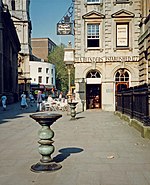Old Post Office, Bristol
Bristol building and structure stubsBristol geography stubsGovernment buildings completed in 1746Grade I listed buildings in BristolGrade I listed office buildings ... and 3 more
Post office buildings in the United KingdomPubs in BristolUse British English from February 2023

The Old Post Office (grid reference ST587729) is a historic building at 48 Corn Street in Bristol, England. It was built in 1746 by Samuel Glascodine to complement The Exchange, acting as the central post office for the city of Bristol for over 200 years. It was part rebuilt as a facsimile of the original in 1993 and is now used as an office. It has been designated by Historic England as a Grade I listed building.
Excerpt from the Wikipedia article Old Post Office, Bristol (License: CC BY-SA 3.0, Authors, Images).Old Post Office, Bristol
Marsh Street, Bristol City Centre
Geographical coordinates (GPS) Address Nearby Places Show on map
Geographical coordinates (GPS)
| Latitude | Longitude |
|---|---|
| N 51.4536 ° | E -2.5958 ° |
Address
Philpotts
Marsh Street 3
BS1 1RT Bristol, City Centre
England, United Kingdom
Open on Google Maps









